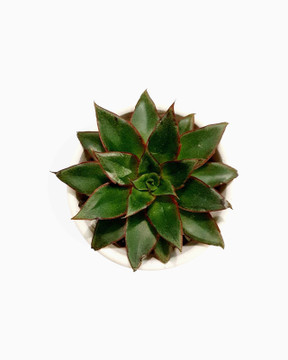

Echeverias are native to remote, mountainous terrain between 1,000 and 4,000 feet elevation. They range from Mexico to Argentina and grow in rock faces and ledges on near-vertical cliffs. Many of the 150 recognized species have been crossed to make new cultivars, of which there are well over a thousand. Most echeverias that are cabbage-like, ruffled, crinkly or bumpy are hybrids (names shown in single quotes).
Echeverias look good in spring due to fresh new growth, but autumn is when they attain their best color. In summer the leaves can be weak and brittle. In winter, plants go dormant and dry lower leaves hug the stem to protect it from cold. Wait until spring to remove dead leaves and tidy the plant.
AIR CIRCULATION: Echeverias do best in dry air and dislike high humidity. Good air circulation keeps pests from settling in.
Water deeply enough for water to run out the drainage hole, then wait for the soil to fully dry before watering again.
| Recommended Light Conditions | Low Indoor Light, Filtered / Partial Sun |
| Maximum Height | 3"-5" |
| Growth Habit / Shape | Loose Rosette, Clumping / Mounding |
| Seasonality | Summer Dormant Partial |
| Product Format | 2.0" Pot |
| Special Characteristic | Slow Grower, Pet Safe |
Echeverias are native to remote, mountainous terrain between 1,000 and 4,000 feet elevation. They range from Mexico to Argentina and grow in rock faces and ledges on near-vertical cliffs. Many of the 150 recognized species have been crossed to make new cultivars, of which there are well over a thousand. Most echeverias that are cabbage-like, ruffled, crinkly or bumpy are hybrids (names shown in single quotes).
Echeverias look good in spring due to fresh new growth, but autumn is when they attain their best color. In summer the leaves can be weak and brittle. In winter, plants go dormant and dry lower leaves hug the stem to protect it from cold. Wait until spring to remove dead leaves and tidy the plant.
AIR CIRCULATION: Echeverias do best in dry air and dislike high humidity. Good air circulation keeps pests from settling in.
Water deeply enough for water to run out the drainage hole, then wait for the soil to fully dry before watering again.
| Recommended Light Conditions | Low Indoor Light, Filtered / Partial Sun |
| Maximum Height | 3"-5" |
| Growth Habit / Shape | Loose Rosette, Clumping / Mounding |
| Seasonality | Summer Dormant Partial |
| Product Format | 2.0" Pot |
| Special Characteristic | Slow Grower, Pet Safe |



There is nothing this team cant fix for you, just quick and great customer support. In the end thats all that matters really!
